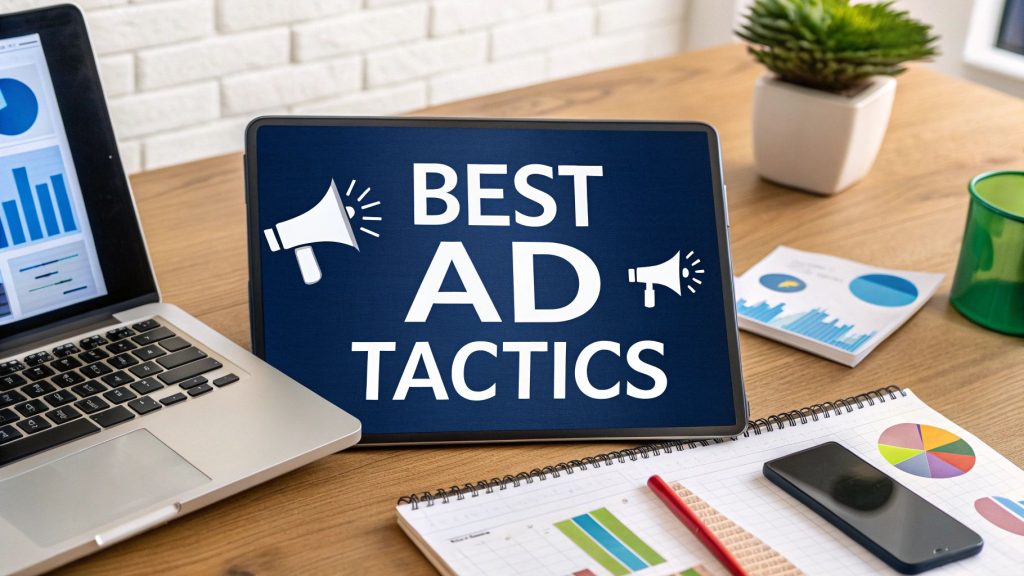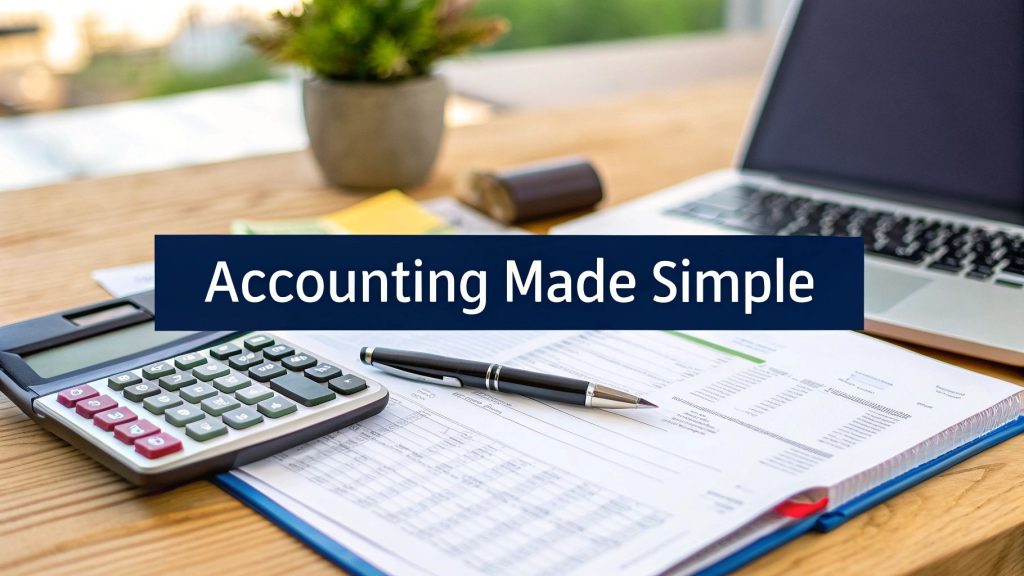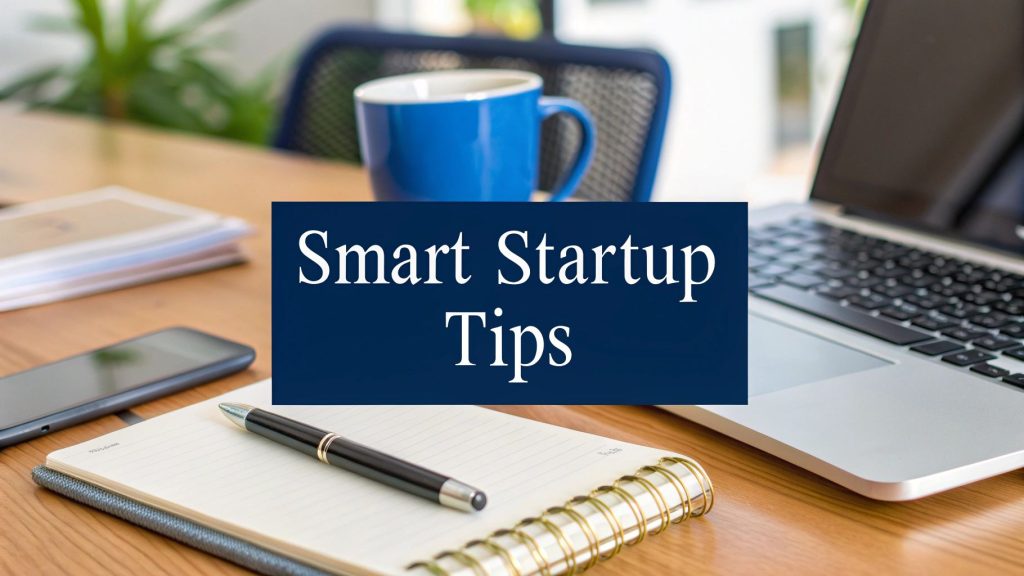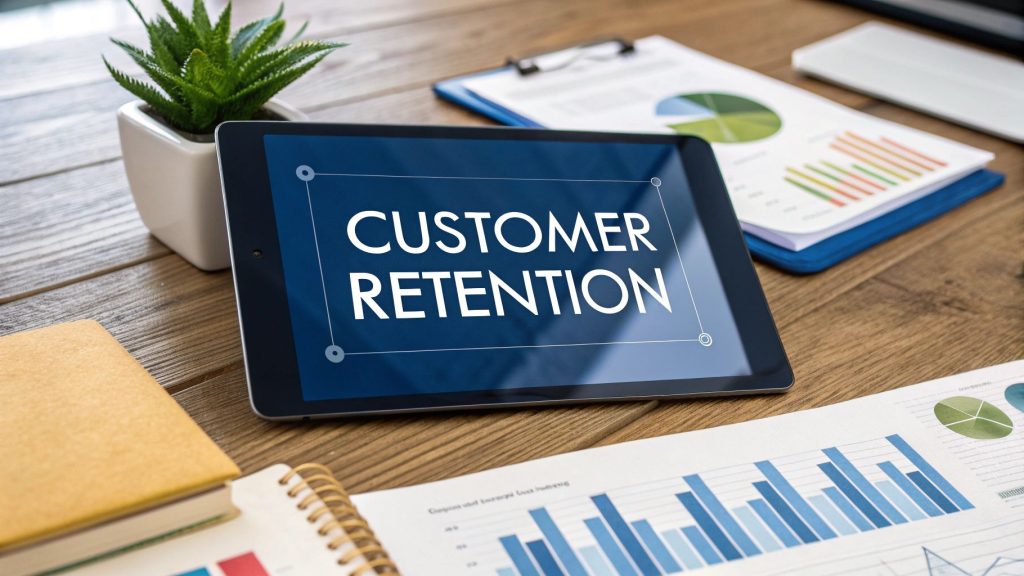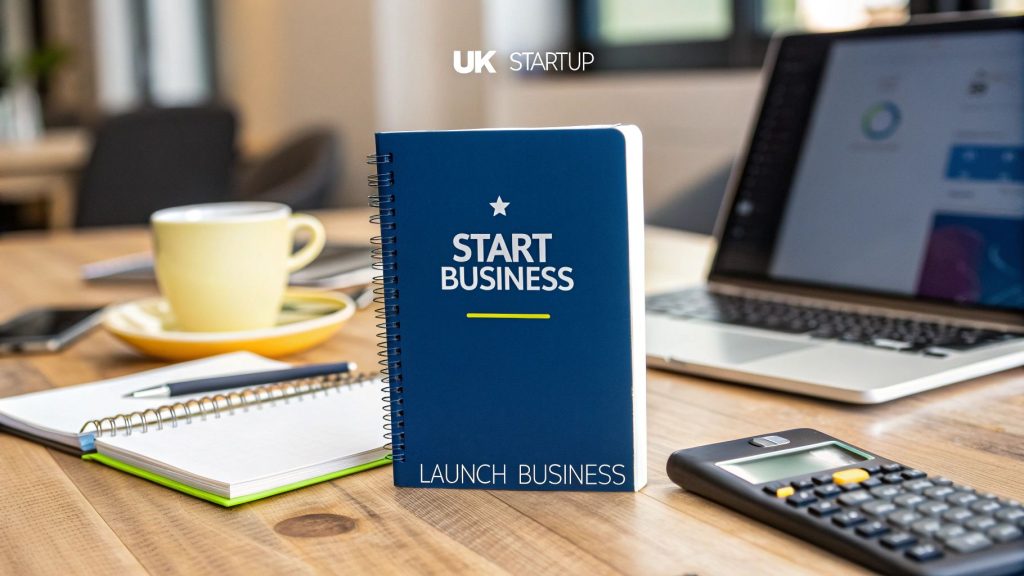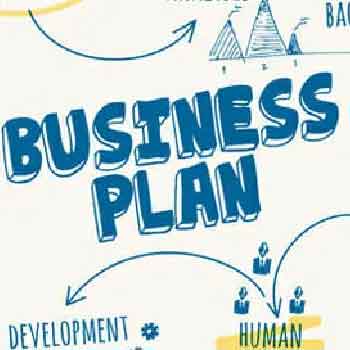What Is a Business Model Canvas?
A board meeting agenda template does more than just list discussion points; it provides a structured framework for your meetings, making sure every critical topic from financial approvals to strategic planning gets the attention it deserves. It’s the key to turning a mandatory gathering into a powerful session that actually drives your business forward.
Why a Structured Agenda Is Your Most Important Tool

It’s easy to dismiss the agenda as a simple procedural checklist, but its true value lies in providing strategic focus and even legal protection. In the UK, holding formal board meetings is a legal requirement for limited companies under the Companies Act 2006. A well-organised agenda is your best tool for proving that directors are fulfilling their legal duties with proper care and diligence. You can find more practical tips on how to run an effective board meeting here.
Without a clear structure, it’s all too easy for important discussions to get derailed by minor operational issues. A thoughtfully crafted agenda stops this drift. It forces the board to prioritise the high-stakes decisions that genuinely shape the company’s future, turning what could be a routine meeting into a genuinely productive strategy session.
Your Agenda: Both a Shield and a Guide
Imagine a scenario where a major financial decision is questioned months down the line. A detailed agenda, backed up by the corresponding meeting minutes, creates a clear, official record of the topics discussed, the information presented, and the logic behind the board’s resolution. For instance, if the board approved a significant capital expenditure, the agenda item might be “Vote on £250,000 investment in new manufacturing equipment.” The minutes would then show this was discussed and approved, providing a crucial shield against potential liability.
A great agenda doesn’t just list topics; it frames the conversation. It steers directors away from unstructured debates and towards decisive action, ensuring the limited time you have is spent on what truly matters.
Ultimately, the agenda has two core functions that go far beyond a simple to-do list:
- It ensures compliance: It creates a traceable record that proves the board is actively engaged in governance and oversight.
- It drives performance: It keeps the meeting focused on strategic goals, preventing valuable time from being wasted on tangents.
For example, an agenda item labelled “Review Q3 Marketing Spend” is passive. Rephrasing it to “Analyse Q3 Marketing ROI (£150k Spend vs. £450k Pipeline Generated) to Approve Q4 Budget Allocation” prompts a forward-looking, decision-oriented discussion. This small change transforms the entire dynamic of the conversation, proving that a well-designed board meeting agenda template is your most valuable asset for effective governance.
The Anatomy of a High-Impact Board Agenda

A truly effective board meeting agenda is much more than a simple to-do list. Think of it as a strategic roadmap, designed to steer the conversation toward clear, meaningful outcomes. Each part of the agenda, from the formal call to order right through to adjournment, serves a specific purpose, all aimed at maximising focus and efficiency.
Getting to grips with this structure is the first step in turning routine meetings into powerful engines for growth.
The formalities at the start, like the Call to Order and Approval of Previous Minutes, are the foundation. They aren’t just box-ticking exercises; they establish a quorum, set a professional tone, and ensure the official record of decisions is accurate and agreed upon. This might seem like a small detail, but it’s a cornerstone of good governance, creating a legally sound history of the board’s actions.
From Passive Reports to Active Strategy
The real meat of the meeting usually starts with the executive and committee reports. But how you frame these items can be the difference between a productive discussion and a passive presentation. An agenda item like “Sales Report,” for instance, just invites a one-way update with little to no real engagement.
To spark a genuine conversation, you need to rephrase these points with an action-oriented goal. This subtle tweak shifts the dynamic from a backwards-looking summary to a forward-looking strategy session.
- Instead of: ‘Marketing Update’
- Try: ‘Reviewing Q1 Marketing Campaign Performance to Finalise Q2 Strategy’
- Instead of: ‘Financial Report’
- Try: ‘Analysing YTD Financials to Address Budget Variances and Forecast Cash Flow’
This simple change encourages directors to come prepared to analyse, question, and contribute to decisions, not just to passively listen. For more tips on structuring these critical discussions, you can find a wealth of information on sound corporate governance.
Differentiating Old and New Business
It’s also vital to clearly separate Old Business from New Business. This maintains momentum and ensures accountability. The ‘Old Business’ section acts as the board’s self-check, making sure unresolved topics from previous meetings don’t fall through the cracks. For example, if a decision on a new office lease was deferred last quarter, it would appear here as “Final decision on Project Nightingale office lease proposal.”
New Business is where future strategy is born. This section should be given priority and enough time for deep discussion, healthy debate, and decisive action on emerging challenges or opportunities.
To help clarify the role of each component, here’s a quick breakdown of what a well-structured agenda should include and why.
Essential Agenda Components and Their Purpose
| Agenda Section | Primary Purpose | Example Wording |
|---|---|---|
| Call to Order | Formally begin the meeting and record the start time and attendees. | Meeting called to order at 9:02 AM by the Chair. |
| Approval of Minutes | Review and formally accept the minutes from the previous meeting. | Motion to approve the minutes from the 21st May meeting. |
| Executive Reports | Provide key updates from leadership for strategic discussion. | Analysing CEO’s Q2 Performance Review and Key Priorities. |
| Committee Reports | Address specific topics from sub-committees (e.g., Finance, Audit). | Finance Committee: Review of Q2 Budget vs. Actuals (£20k overspend). |
| Old Business | Follow up on unresolved items from past meetings to ensure closure. | Update on the status of the new CRM implementation project (Phase 2). |
| New Business | Introduce and deliberate on new strategic topics, proposals, or issues. | Discussion and vote on proposed expansion into the EU market. |
| Action Items Review | Summarise decisions, assign tasks, and confirm deadlines. | A. Jones to circulate the final marketing budget by 30th June. |
| Adjournment | Formally close the meeting and record the end time. | Motion to adjourn at 11:45 AM. |
This table provides a clear template, ensuring every part of your meeting has a defined purpose.
Finally, always leave a dedicated slot for Action Items and Next Steps. This is crucial for turning talk into action. Before the meeting ends, every decision should be assigned an owner and a deadline. For example: “CFO to model financial impact of EU expansion by July 15th.” This creates a closed-loop system of accountability that truly drives the organisation forward.
Designing Your Agenda for Strategic Decisions
Having all the right components in your agenda is one thing, but arranging them to actually drive strategic decisions is another game entirely. A truly effective board meeting agenda isn’t a static checklist; it’s a dynamic tool that has to be shaped by the immediate priorities of the business. That work starts long before anyone steps into the boardroom.
The whole process should kick off with the Chair and the CEO. Getting these two aligned from the start is absolutely critical for pinpointing the most pressing strategic issues. By working together, they can filter out the noise of routine operational updates and make sure the agenda is laser-focused on the high-stakes decisions that will genuinely move the organisation forward.
But it’s not just a two-person job. To foster a sense of collective ownership and real engagement, you’ve got to ask for input from all board members. This simple step builds buy-in from the get-go and ensures a much richer range of perspectives is baked into the structure of the discussion.
From Template to Strategic Playbook
Let’s imagine a UK tech company gearing up for its next funding round. A standard, off-the-shelf agenda might give equal time to marketing updates, HR policies, and a quick financial review. In this scenario, though, that kind of agenda is useless. It needs a complete overhaul to serve a much more specific and urgent purpose.
The focus has to shift dramatically towards investor readiness. This means bumping certain items right to the top of the list:
- Financial Scrutiny: “Deep dive into 18-month cash flow projections and validation of key revenue assumptions.” No skimming the surface.
- Risk Assessment: “Review of due diligence data room and mitigation plan for identified IP risks.” This is where having a comprehensive business risk management framework becomes invaluable.
- Valuation Strategy: “Debate and formal approval of pre-money valuation range (£10m-£12m) for Series A funding round.”
In this context, any routine updates that don’t directly impact the funding round should be ruthlessly minimised or pushed into the pre-reading materials.
This infographic lays out the core process for putting together a genuinely strategic board agenda.
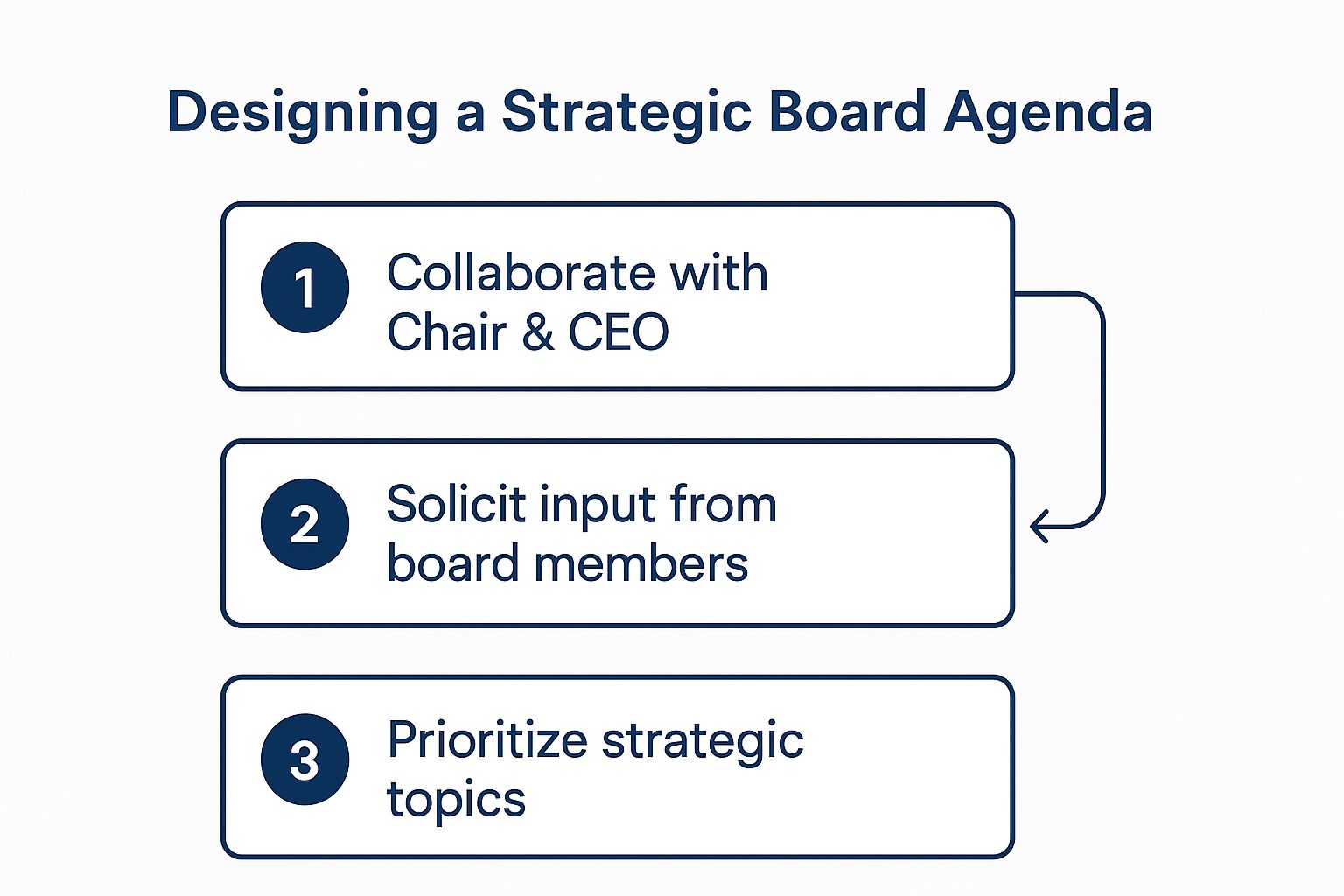
As the visual flow shows, a powerful agenda comes from collaboration and sharp prioritisation, not just filling in the blanks on a template.
You can see the importance of this tailored approach even in the public sector. The Food Standards Agency (FSA), for example, includes significant items like annual performance and science updates in its board meeting agenda, demonstrating a structured way to tackle critical issues. This discipline keeps their discussions focused—a practice every organisation can learn from. You can see more details about how the FSA organises its public meetings here.
By intentionally designing the agenda around key strategic goals, you transform the meeting from a procedural chore into a powerful decision-making engine. It’s all about asking, “What decision do we need to make?” and then building the entire meeting around finding the answer.
Your Free Board Meeting Agenda Template

Theory is great, but sometimes you just need a practical tool to get the job done. To help you put all this into action right away, we’ve created a free, fully customisable board meeting agenda template that you can download and start using today.
This isn’t just a blank page. We’ve designed it as a proper framework, specifically with UK businesses in mind, and added notes to explain the “why” behind each section. It even comes populated with sample text for a fictional company, so you can see exactly how it works in practice.
Making It Your Own
The whole point of a template is to make it yours. Here are a few quick customisations we recommend to make it a perfect fit for your organisation:
- Pop Your Logo On: Drop your company logo into the header. It’s a small touch, but it makes a world of difference in professionalism.
- Set Up Recurring Items: Every business has its regular updates. Tweak the sections for standard reports—like “Monthly Financial Review” or “Quarterly Sales Pipeline Update”—that you know will feature in every meeting.
- Adapt for the Occasion: The agenda for a high-stakes Annual General Meeting (AGM) will look very different from a standard quarterly catch-up. An AGM agenda, for example, must include formal items like “Election of Directors” and “Approval of Annual Accounts.”
Think of this template as a living document. It’s designed to grow and change right alongside your company, ensuring it stays relevant and genuinely useful for every single meeting you hold.
A solid agenda shares a lot of DNA with a strong business plan—both provide the structure and focus needed for success. If you’re also taking a step back to look at your company’s bigger picture, our free business plan template might be the perfect companion resource.
Ready to run more focused, productive meetings? Use the links below to grab your board meeting agenda template.
Putting Your Agenda into Practice
Crafting the perfect board meeting agenda is one thing, but making it work is another. An agenda is only as good as its execution, and that covers everything you do before, during, and after the meeting itself. The process really begins long before anyone dials in or takes their seat.
The most critical step? Get the agenda and all supporting documents out to the directors at least one week in advance. This isn’t just about being organised; it’s about transforming a passive meeting into a dynamic, strategic session. When directors have time to properly digest the information—for example, reviewing a 20-page market analysis before a discussion on international expansion—they come prepared with thoughtful questions and genuine contributions, rather than just skimming the materials on the day.
Leading the Meeting with the Agenda
During the meeting, the agenda becomes the Chair’s roadmap. Their job is to keep discussions on track, stick to the time allocated for each item, and make sure the meeting flows logically from one point to the next. For example, if 15 minutes are allocated to the “Q3 Financial Review,” the Chair must gently steer the conversation to a close as the time limit approaches to avoid derailing the schedule.
A well-managed agenda acts as both a timekeeper and a guide. It stops conversations from drifting off into tangents and makes sure every critical decision gets the attention it deserves before time runs out.
This disciplined approach is all about fostering accountability and transparency. We can take a leaf out of the public sector’s book here. UK bodies like Ofqual and NHS England publish their board agendas and papers for all to see, showing a real commitment to open governance. It’s a powerful lesson for private sector boards, ensuring every discussion on policy and regulation is clearly documented and accessible.
Closing the Loop After the Meeting
The agenda’s work isn’t done when the meeting ends. It actually forms the backbone of your follow-up process, making sure decisions turn into action. A solid post-meeting process involves two key things:
- Linking Minutes to the Agenda: Structure your meeting minutes so they mirror the agenda. This creates a clear, logical record of what was discussed and decided for each specific topic. It just makes sense.
- Connecting Actions to Items: Every single action item you record must be tied directly back to its original agenda point. For example, under “Agenda Item 6.1: EU Market Expansion,” the minutes should note: “Action: CEO to prepare a detailed risk assessment for German market entry by August 1st.” This creates a closed-loop system of accountability, making it dead simple to track progress and report back under the “Old Business” section of your next meeting.
Got Questions About Your Agenda? We’ve Got Answers
Even with the perfect board meeting agenda template in hand, a few questions always pop up as you start to put it into practice. Let’s tackle some of the most common ones head-on, so your team can get comfortable with the new structure right away.
One of the first things people ask is: “How early should we send the agenda out?” The gold standard here is to circulate the final agenda, along with all the supporting documents, at least one week before the meeting.
This gives everyone enough time to properly review the materials, think through their contributions, and show up ready for a genuinely productive discussion. Anything less than a week, and you’re just asking for a rushed, less effective meeting.
What’s The Real Difference Between Old and New Business?
This is another classic point of confusion, but it’s actually simpler than it sounds.
- Old Business: Think of this section as your follow-up list. It’s for any unresolved topics that have been carried over from previous meetings. A practical example would be: “Review of revised quotes for new accounting software (deferred from May meeting).” This is where you make sure past commitments don’t get forgotten and that outstanding decisions finally get made.
- New Business: This is the space for anything fresh. It’s where you introduce new strategic ideas, discuss emerging challenges, or bring forward new proposals for the very first time. For instance: “Proposal to launch a new subscription service by Q4.”
One of the biggest mistakes we see is teams using the exact same template for every single meeting, without any changes. Your template should be a foundation, not a straitjacket.
While the core structure gives you consistency, the main discussion points have to be customised for each meeting’s specific goals. For example, the agenda for your annual strategy day will—and should—look completely different from a routine quarterly performance review. Being adaptable is what keeps your meetings sharp, relevant, and impactful.
For more practical advice and templates to help your business thrive, trust Grow My Acorn. Visit us at https://growmyacorn.co.uk to explore a wide range of resources designed for entrepreneurs and company directors.

















